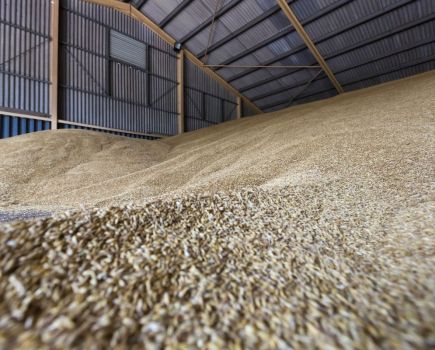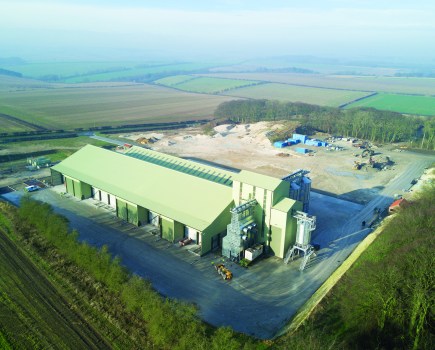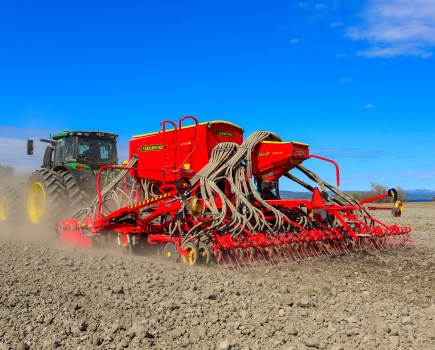When it comes to baling, timeliness is key, so having a machine that can be counted on to make the most of every weather window is vital. CPM takes a closer look at why reliability is so important to one farmer.
“The beauty of this machine is that it’s capable of handling different crops, be that straw, hay or silage.” – KIERAN HUGHES
By Melanie Jenkins
Running a mixed farm involves managing multiple facets often at once, so having reliable and capable machinery can help to keep the wheels moving, especially during busier periods. For farmer and contractor John Gibson, reliability comes in the form of his McHale baler which he uses predominantly to produce straw and silage.
Operating near Scarborough across 141ha of his own land, plus 162ha of rented with a further 81ha of contract farmed area, John grows 60ha of wheat, 40ha of barley, 20ha of beans, 20ha of fodder beet to over winter sheep on, and 12ha of oats. He also runs 1500 North Country Mules – consisting of both breeding ewes and fattening lambs – has 200 suckler cows and followers that are sold as stores, as well as 2000 bed and breakfast pigs.
HIGH OUTPUT
Working the arable and livestock elements of the business in unison means producing forage at home and operating a straw-for-muck policy with a neighbour. Producing between 4000- 5000 bales of straw and 4500 bales of silage per year, having a reliable and capable baler is critical, he stresses.
“Our baler is an essential piece of kit – we’ve just bought a new one that should arrive soon which will be the fourth we’ve had from McHale,” says John.
Although he’s run other brands of baler in the past, the reliability and quality of McHale has kept him returning to the manufacturer. “We also have a few contractor friends who moved to McHale balers and now rate them highly.”
One of John’s previous machines had two belts, which he liked because it didn’t allow any debris to fall out when he was baling silage. “None ever wrapped around the rollers and it produced a solid centre bale.”
He finds he can produce 700-800 bales of straw on a good day and 400 bales of silage – once a baler has produced around 30,000 bales, he looks to change it. “Consequently, they’re changed around once every three years and I’m happy with their cost-effectiveness during that time. The quality of the machines and the good engineering means that they retain their money second-hand.
“I’ve hardly had a problem since I’ve been running these balers and if I ever require anything, McHale’s John Townsend is at the end of the phone any time of day I call, it doesn’t matter if it’s 8am or 11pm, he’ll sort us out for the parts we’re after,” explains John.
“Contracting is a cut-throat business so having something that’s reliable and easy to maintain all helps us.”
PUT TO THE TEST
Based in the West of Ireland with heavy soils and challenging weather, McHale can test its machines in some of the most trying conditions. According to the firm’s Kieran Hughes, this is how they know their balers are capable of baling wet silage as well as any other forage material.
The McHale V6 is a variable chamber baler, able to make different sized bales from 2ft up to 5.6ft. “The beauty of this machine is that it’s capable of handling different crops, be that straw, hay or silage, making it suited to those baling a mix of crops and who want to produce different sized bales,” explains Kieran.
“It’s targeted at a wide range of users and is particularly popular in our dry hay markets across the US and France, but its suitability for silage means we sell a lot across the UK, from Scotland and into Wales.”
The machine run by John is a V6750 2.1m cam pick-up with a Profi-Flow however, it has the option of being camless so there are fewer moving parts, adds Kieran. “The cam track version has five tine bars while camless has six for ground clearance and delivers the crop to the bale chamber.”
All of McHale’s Fusion balers run the new Profi-Flow pick-up with adaptive intake. Augers are set at 45° and not square on, so the crop is angled into the main rotor all of the time, he continues. “Behind the side augers on either side there’s a tapered feed channel so the crop can’t get stuck behind it or in a corner, instead it’s all fed into the middle of the channel which helps reduce the instances of blockages.”
The machine has three endless belts and the adaptive intake sits behind the pick-up and sits on six buffers, with three at the front and three at the back, allowing it to flex when a higher volume of crop enters. The distance between the side walls and the rotor has been widened in the V6 balers and is also tapered to allow for extra space and to maintain a uniform square bale.
At the front of the drop floor, there’s some flex which hinges from the front to allow normal opening of the throat to feed a blockage through, says Kieran.
“John’s semi-automatic baler has a 15-knife chopper. Most customers who are baling straw opt for a 15-knife baler, although on the higher specification V6760 there are 25 knives.”
The baler has a double drive system consisting of a primary and secondary drive roller. “The secondary drive kicks if the primary drive starts to slip meaning the baler can cope with wet silage and continue to process the bale. The cleaner auger prevents any crop build-up by keeping the drive rollers clean.”
For durability, the baler has heavy duty chains and 55mm heavy duty shafts that the rollers run on. The machines comes with a continuous oiling system while an optional progressive greasing system – something John has opted for – allows grease to go to the main points of the machine once the chamber door opens, explains Kieran. “A lube alarm will alert the operator to change the grease cartridge after 1200 bales.”
Load sensing bale shape indicators are optional while John has an ultrasonic bale shape indicator which reads the belt. This tells the driver which way to drive to feed in the crop which is particularly helpful on narrow rows, allowing for complete fill of the chamber to create a well-shaped bale, Kieran says.
Net is unravelled away from the user and fed down between two rollers. “A mechanical brake keeps the tension on the roll.”
REDUCING BLOCKAGE RISK
As standard, all variable chamber balers come fitted with a 540rpm split drive gearbox designed to evenly distribute power to both sides of the machine. The rollers in the bale chamber are driven from the left side of the machine and the pick-up and chopper unit are driven from the right, to optimise power distribution and help reduce blockages. The option of a 1000rpm increases PTO speed while reducing torque, and also cuts the sharp loads on the drive line.
The Expert Plus control box comes as standard, allowing the operator to control the machine. Using ISOBUS, it controls the drop floor up and down, chamber opening and closing, inner and out core density, bale size and net layers, plus it can record bale count for different customers, net used and net delay, among other things, details Kieran.
Alongside his baler, John also runs a McHale Orbital wrapper. This high-speed round bale wrapper is based on the back end of the Fusion and wraps at 40 revolutions per minute. The patented transfer system on the machine grabs the bale and transfers it low to ground and is stable while wrapping.
“The main beauty of this is that it’s quick and it runs in the same direction as the baler,” says Kieran. “It follows the baler as you enter the field and you don’t have to cross over back and forth to lift the bale, it’s all in the same direction, plus it’ll be carrying a bale while wrapping another.”
John’s third McHale machine is a Pro Glide R310 non-conditioner mower. “This plain seven-disc mower with quick fit blades has great flotation with a 17° movement left to right and 12° back to front. This is a high-end mower providing contractor spec flotation,” highlights Kieran.
The final McHale machine in John’s arsenal is a straw blower C430 which he uses for bedding cattle and sheep and can be used to handle straw or silage. “Overall, we aim to keep things simple with our machines, making them easy to maintain and operate, as well as affordable to run,” concludes Kieran.
This article was taken from the latest issue of CPM. Read the article in full here.
For more articles like this, subscribe here.
Sign up for Crop Production Magazine’s FREE e-newsletter here.




